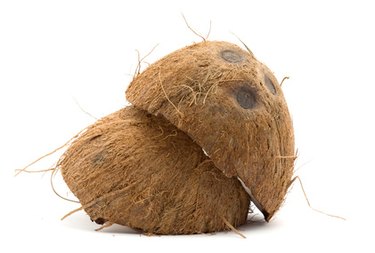
Coconuts contain white, juicy flesh and a delicious drink commonly called "coconut water." These nuts grow on the tropical coconut palm (Cocos nucifera), known as "the tree of life," which reaches up to 30 meters in height and provides not only food, but also clothing, building materials and wood. Unusual uses for coconut shells include the construction of gas masks.
Household Items
Video of the Day
After the nuts are split in two and the edible meat is removed, the cleaned and dried shells provide a variety of household utensils. These include ready-made drinking vessels, bowls for cooking and eating as well as a variety of spoons and ladles. With a little carving, coconut shells are crafted into salad servers and even hookahs for smoking tobacco. Highly decorated versions of these everyday utensils, as well as purses, picture frames and rattles, (often featuring the name of the area) are purchased by visitors as mementos of their travels to regions such as southern Asia where the coconut palm grows plentifully.
Video of the Day
Fuel
Coconuts provide nourishment in the form of meat, oil and water, as well as the means to cook up a meal. The untreated coconut shells (either used whole or cut into sections), burn quickly and make a hot cooking fire. In countries like India, which is the world's biggest producer and exporter of coconut products, empty coconut shells are used to make charcoal bricks for cooking. This process involves burning the cut up shells in a low-oxygen environment which removes most of the moisture and creates a light-weight, long-burning product that is easy to export.
Aquariums
Coconut shells are used as small caves for aquariums and make especially good hideaways for female fish escorting fry. Home aquarium enthusiasts with a squid in the tank can try adding a couple of halved coconut shells in the hope of observing new phenomena. According to National Geographic, octopuses near the Indonesian coast were observed cleverly using two coconut half-shells as mobile homes. The creatures use tentacles to grasp and carry the shell parts while traveling, then simply reassemble the nuts while resting. This tough home, which offers them a unique disguise, caused a stir among biologists like Mark Norman, who commented, "we were blown away, it was hard not to laugh underwater and flood your (scuba) mask."
- Plant Cultures: Coconut Crafts
- Coconut Research Center: Cocos nucifera
- National Geographic: Octopuses Carry Coconuts as Instant Shelters
- Aquarticles: Apistogramma cacatuoides
- Planet Green: Inventing New Uses for Coconut Shells
- Palm Trees: Palm Trees, Cycads, Bromeliads and other Tropical Plants
- Coconut Museum: The Many Uses of the Coconut